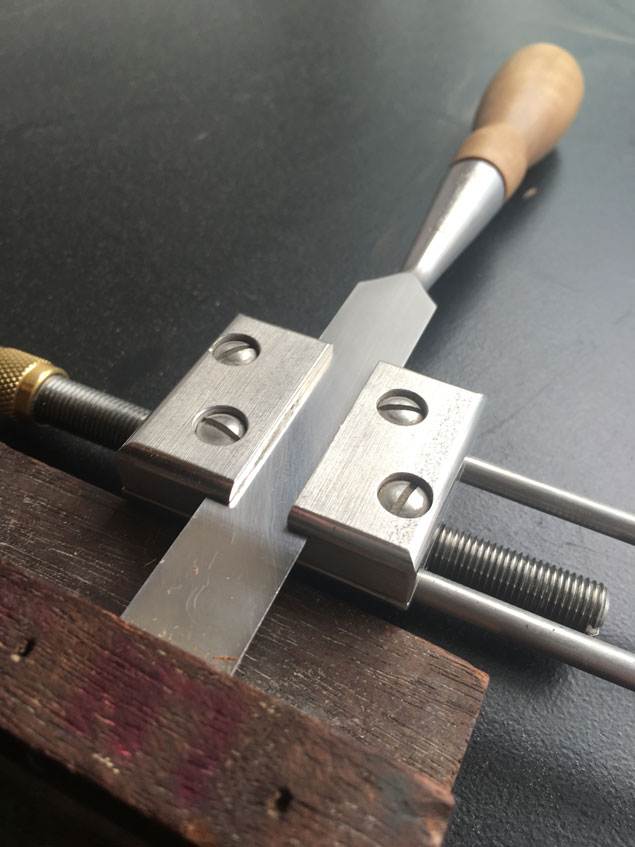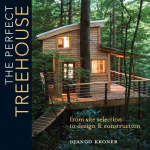We may receive a commission when you use our affiliate links. However, this does not impact our recommendations.
I sharpen all of my plane irons and chisels at 35°.
Here’s why: I do this to keep my sharpening regimen as simple as possible. I don’t want to pick up a tool and wonder: What angle is this sharpened to? I also don’t want to sharpen a tool, discover that I used the wrong angle and have to resharpen it immediately. And I don’t want to have multiple jigs to set my tools. Or be forced to engrave my sharpening angle on every tool.
I know that lots of woodworkers will call this a wrong-headed approach. But here is why I have been doing this for the last six years.
- I find that keeness is more important than small differences in cutting geometry. With a 35° cutting edge I can cleanly pare the end grain of white pine, and that’s all I need to know. If your tool can do that operation, it is wicked sharp and can handle anything.
- Higher angles are more durable. A 35° tool goes a little longer between sharpenings than a 25° tool. Less sharpening means more woodworking.
- A 35° angle won’t interfere with the operation of any handplane that I know of. I chose this angle with care. A higher angle could end up fouling the clearance angle of some tools. But 35° works with every tool I’ve ever touched.
- A 35° secondary bevel combined with a 25° primary bevel is an ideal combination. The higher-than-usual secondary bevel is smaller than a 27° or 30° secondary bevel. A smaller secondary bevel means less honing and polishing time.
I set the 35° sharpening angle using a simple jig made from two blocks of wood nailed and glued together. To be honest, it’s not dead-on at 35°. I don’t know the exact angle. But it’s in within a half degree or so, and what is most important is that the angle doesn’t change. It’s always that same angle when I put my tool into my honing guide. So when the tip of the tool touches the sharpening stone it is immediately honing that tool at the perfect angle (whatever angle that is).
If 35° seems drastic to you, try 30° instead. That sharpening angle is quite common among hand-tool woodworkers, but it’s a little less durable.
The point is to pick one angle and stick with it. For years I kept my tools at all sorts of different angles. My set of chisels used three different angles. I used 35° for the small chisels that were for light chopping, 30° for the middle-sized tools that were for chopping or paring and 27° for the wide chisels that were for paring only. I had steep angles for mortising chisels and plane irons used for figured woods.
Perhaps I’m just a simpleton, but keeping up with the angles was an annoyance. And so one day I threw away all my jigs for setting these different angles and made one for 35°. And I slowly converted every tool in my chest to that angle.
— Christopher Schwarz
Here are some supplies and tools we find essential in our everyday work around the shop. We may receive a commission from sales referred by our links; however, we have carefully selected these products for their usefulness and quality.










It seems that most chisels come with 25 degree bevels. Not knowing any better, I flatten & polish the backs and then do the same to the bevel, keeping the 25 degrees.
Last year I purchased a beautiful set of the new Stanley socket chisels and discovered that the bevel was 30 degrees. I went to a lot of work and labor to change the bevel to 25 degrees. Now with some of the above ‘enlightment’ perhaps I didn’t need to change the bevel angle. I now have an open mind on the subject.
I do agree that a micro bevel does save a lot of time in sharpening.
This is so incredibly timely. I have a cheat sheet setup near my sharpening area and having just sharpened a bunch of tools I found it maddening to constantly change things around.
But here is my question: how do I get from said maddness to nirvana?
Do I have to regrind everything and start from scratch or just set the secondary bevel at 35 degrees at my next sharpening session? It seems like the later makes sense but I may be missing something.
Thanks,
Shawn
Chris,
It seems these ideas are a bit too radical for some of the brethren.
I have used 35 degrees in bench planes for many many years, the slight change of clearance angle does not seem to be a problem. (5 degrees difference on a cutting edge can make a huge difference where chipping is concerned).
My Japanese chopping chisels are all polished at 35 degrees because they are extra hard and therefore somewhat brittle.
A2 chisels seem happier at 35 degrees, while I will have to admit to polishing my long paring chisels, Japanese and A2 at 33 degrees. The Nirvana of unified angles has not quite been attained!!!
Finally the block plane issue. On large dense endgrain, like my bench tops, a sharp bench plane does an excellent job. The effective pitch is 45 degrees so I concur that sharpness is more important than effective pitch angle.
Best wishes,
David
With your old “ubiquitous” honing guide you had two different set up blocks for plane blades and chisels with different distances for the same angle. With the new LN honing guide is the distance from set up block to honing guide edge the same for chisels and plane blades? Is that why Deneb’s jig plan is no longer available?
And is it 10 or 12 coats of French Polish this time???
Shaun
I dislike sharpening, begrudge the time it takes and so, save for that rare special case, I sharpen everything to the angle given by my hand grinder equipped with a reasonably new wheel. I then hone on oilstones to whatever secondary angle is given by slighting raising the tool, once I feel the primary bevel resting on the stone. I was taught this method some forty years ago, by the resident marina shipwright, and I set up the rest to my hand grinder at that time. I remember setting it to the angle suggested on the cap iron of the new Record No. 5 I had just bought, but what that angle is, or what my secondary angle is, I couldn’t tell you off the top of my head. Must be within spec, since I haven’t had any cause to complain. I’ve tried other methods, thinking perhaps I was missing something, including special angles and jigs of various sorts, but have always become impatient with the fussiness of it all. To my way of thinking, life is too short, and my brain too small, to fill either with too much sharpening.
Are we talking clearance angle or cutting angle?
Dang. Seems like I’ll waste a lot of steel going from 25 to 35….
David Charlesworth also uses (or used in 2008) a 25 degree primary and 35 degree secondary bevel in plane irons (https://www.popularwoodworking.com/techniques/the_ruler_trick/2). I stumbled onto that just a few weeks back while looking for details on the “ruler trick”. Those angles were put to work last week on an old Stanley 3 and I loved the results. Good to know this works well for chisels too – I’m going to try those angles on one this weekend.
Another really good reason to sharpen at 35 is that it seems to be the best angle for A2 steel. At 30 or lower angles the edge of an A2 chisel appears to “crumble” as it wears. Sharpening at 35 seems to fix that problem. Since it only takes about a minute to sharpen a chisel using a honing guide, the longevity of the edge is not a big issue.
About that longevity thing, a Canadian guy Normand Leblanc, actually tested this theory. He found that clearance angle is more important then sharpening angle for edge retention in a plane. He found the best result at a 28 degree sharpening angle and a definitive drop in performance when you go much beyond 30 degrees. The effect seems to be stronger for A2 then for simple high carbon steels. All in all I would say that 30 degrees is the most universal sharpening angle from his studie. Somehow that doesn’t really come as a surprise.
Have a look at his website when you have a few minutes to spare.
http://oldchips.blogspot.nl/2016/06/study-plane-iron-clearance-angle.html
I’ve gone for 30 on everything at the moment. Would changing to 35 be a better bet all round?
Si
Just to clarify in 4, when you say “The higher than usual secondary bevel is smaller …” I’m assuming that you mean the length of the “flat” of the secondary bevel, right? From that then you can infer that you will be able to hone that secondary bevel more times before it gets so big you have to regrind the primary bevel compared to a lower secondary bevel. If I’m correct in my interpretation then there is really a double benefit – more durable edge and you have to regrind less often.
My only question is what about the block/ bevel up planes? 35° there too?
Surely this calls to the wrong type of laziness? I know my tools well enough that I know which is 22,5° and those of specific angles for hammered. You’ve clearly got too many tools.
Yeah, but then I don’t get to use my Richard Kell angle disc thingy to try and figure out what angle I used the last time because I’m too lazy to engrave it on the blade. Or my LN multi-setting board I laboriously made for 25, 30, and 35 degree settings.
Actually… I don’t really care for the angle guide. Either of them. Might just give your idea a go for a bit and see how I feel after a year.
Thanks for the thoughts.